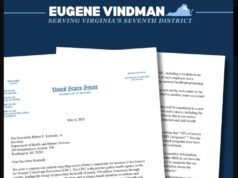On Sunday, CBS News came out with a poll showing Clinton/Kaine defeating Trump/Pence in Virginia by 12 points (49%-37%). There have been other polls of Virginia, and the Real Clear Politics average has Clinton/Kaine ahead in Virginia by somewhat less than that (7.0 points). But since the CBS News poll was the first since the conventions, for now let’s focus on that one, keeping in mind that Clinton-Kaine’s lead is probably not as high as 12 points (although we can certainly hope!).
Anyway, the question is, if Clinton/Kaine really do win Virginia by 12 points, what would that mean downballot for House of Representatives races? Keep in mind that Barack Obama won Virginia by 3.87 percentage points in 2012, so a 12-point win by Clinton-Kaine in November 2016 would basically equate to an additional 8+ points statewide. Of course, people are quite capable of splitting their tickets (e.g., Republicans could vote for Gary Johnson or Evan McMullin for President, then vote for the Republican House candidate), so an extra 8 points for Clinton-Kaine does NOT translate automatically into an extra 8 points (or possibly any points at all) for the Democratic House candidate in a particular district.
With that, here are some thoughts, district by district.
District 1: This district is a solidly “red” one, going for George Allen in 2012 (53%-47% over Tim Kaine); Mitt Romney in 2012 (53%-45%) over Barack Obama; and for Ed Gillespie in 2014 (55%-42%) over Mark Warner. As for Rep. Rob Wittman, in 2012 he defeated Democrat Adam Cook by 15 points (56%-41%). So, even if Clinton-Kaine win the state by 8 points more than Obama-Biden did in 2012, it’s hard to see how this year’s Democratic nominee, Matt Rowe, can make up the difference. I’d say the best-case scenario for Rowe would be to make it 8 points closer, maybe get within 7 points or so of Wittman? More likely, my guess is that Rowe couldl end up in the mid 40s given a Clinton-Kaine Virginia blowout.
District 2: This is the “what might have been” district, as the DCCC tried – but unfortunately failed – to recruit a “top-tier” candidate in this “purple” district (Kaine got 52% here in 2012; Obama got 50%). Making matters even more frustrating, this is a district in which the incumbent (Rep. Scott Rigell) is stepping down, making it an open seat race between Republican nominee Scott Taylor vs. Democratic nominee Shaun Brown. Now, if Democrats had a strong, well-financed candidate in this district, I’d definitely say it would be winnable, as Rigell won with just 54% of the vote in 2012, particularly assuming Clinton-Kaine kick butt in November. Of course, whether Democrats could HOLD the seat in 2018 is a totally different story, and in my view, that’s why none of the “top-tier” recruits (e.g., Jody Wagner, Lynwood Lewis) ultimately decided to take the plunge…
District 3: This district was made significantly less Democratic due to court-ordered un-gerrymandering (I know, that’s not a word). Regardless, Rep. Bobby Scott is totally safe here, although perhaps he’ll “only” win this time around by 40 points or whatever, instead of 63 points as he did in 2012. Then, the question is whether Scott will be appointed to the U.S. Senate by Gov. McAuliffe, assuming Tim Kaine becomes VP. From everything I’m hearing, Scott very much wants to be in the Senate, and it’s hard to see McAuliffe turning him down. Stay tuned on that front…
District 4: Another district that changed dramatically (this time in the “blue” direction) due to court-ordered un-gerrymandering, this one is safe for soon-to-be Rep. Donald McEachin, no matter if Clinton-Kaine win Virginia by 8 points, 5 points, 3 points whatever. This district will represent a pickup – and an enormous improvement – for the Democrats from current Rep. Randy Forbes (R).
District 5: Now THIS could be an interesting race, with 1) a strong Democratic nominee (Jane Dittmar) running against a far-right Republican (Tom Garrett); 2) a district won relatively narrowly by Mitt Romney with 52% of the vote in 2012; and 3) an open-seat race, as incumbent Rep. Robert Hurt is stepping down. Clearly, though, for Dittmar to win, she will have to both run a great campaign AND hope that her opponent makes some mistakes AND get some help from the top of the ticket. Of course, a 12-point win by Clinton-Kaine would certainly constitute “some help,” potentially gaining Dittmar a few points and making this a tough-but-potentially-winnable race. Definitely keep your eyes on this one…
District 6: Rep. Bob Goodlatte (R) is absolutely abysmal on all fronts, but he’s also an entrenched incumbent in a deep, deep-red district, with an enormous cash advantage to boot over Democratic nominee Kai Degner. So…basically, no matter how much Clinton-Kaine win Virginia by this November, Goodlatte will cruise to victory here, probably by 25-30 points. Sigh…
District 7: Another deep-red district (Romney won it by 16 points in 2012), unfortunately, as Democratic nominee Eileen Bedell would be infinitely superior – and I really mean infinitely in this case – to far-far-right wingnut, obstructionist and know-nothing Rep. Dave Brat (R). But I just don’t see how any Democrat can overcome the enormous, gerrymandered Republican advantage in this district, no matter how big Clinton-Kaine’s margin of victory is in Virginia this November. Ugh.
District 8: An overwhelmingly Democratic district (Arlington, Alexandria, Falls Church, parts of Fairfax County) with a well-liked and well-funded incumbent, Rep. Don Beyer. This district will not be even close to competitive — the only question being whether Beyer wins by more than the 32-point margin he racked up in 2014. Go Don Beyer (and then let’s see if he ends up in the Clinton administration or possibly even as Gov. McAuliffe’s pick for Tim Kaine’s Senate seat)!
District 9: This district is about as “red” as you can get — Romney got 63% of the vote in 2012, Ed Gillespie beat Mark Warner by 21 points in 2014, etc. That’s highly unfortunate, given how godawful Rep. Morgan Griffith is. So, I wish Democratic nominee Derek Kitts luck, and hopefully he can get into the low 40s against Griffith?
District 10: Without a doubt, THIS is the House race in Virginia to watch on the evening of November 8, as well-financed, “red-to-blue” Democratic nominee LuAnn Bennett takes on one-term oppo researcher/Congresswoman Barbara Comstock (R) in a “purple” district won by just one point by Mitt Romney in 2012. The question here is whether a big statewide (and district-wide) win by Clinton-Kaine will pull enough votes to help Bennett overcome Comstock. Keep in mind that Marco Rubio won the Republican primary in this district (with 37.0% of the vote) over Trump (who only received 29.4% of the vote), so it’s not like Trump is popular here. No wonder why Comstock refuses to endorse Trump, while simultaneously refusing to denounce him…a weird, tough balancing act that she’s trying to maintain through election day. We’ll see if Comstock can pull it off. Again, voters are quite capable of splitting their tickets (we saw it all the time with Frank Wolf), but three points: 1) Comstock’s no Frank Wolf; 2) Trump could really be a drag in this district; and 3) a big Clinton-Kaine win statewide could mean that they carry the 10th by a few points, meaning that if people voting for Clinton-Kaine simply vote for LuAnn Bennett, then Comstock is outta there. Let’s hope.
District 11: Rep. Gerry Connolly is unopposed in this safe ‘blue” district.














![Monday News: Trump’s Lunacy Pushes China, Russia, India, etc. Together; “Happy Labor Day. Donald Trump and Elon Musk Are Screwing Workers.”; “Where is the [media’s] intense focus on Trump’s failing health?”; ““Trump says he is not a dictator. Isn’t he?”](https://bluevirginia.us/wp-content/uploads/2025/09/montage0901-100x75.jpg)